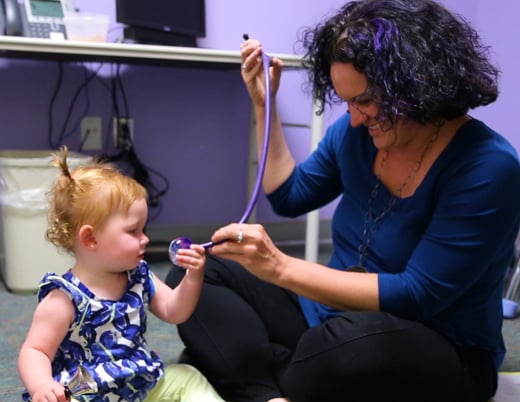Key takeaways
-
Five-year follow up compared TEEN-LABS and TODAY study participants for DKD rates in severely obese youth with type 2 diabetes
-
Surgical treatment substantially lowers the odds of DKD (hyperfiltration and elevated urinary albumin excretion)
-
Longer-term studies are needed to determine if less invasive vertical sleeve gastrectomy provides similar long-term outcomes to gastric bypass and to identify new non-surgical approaches for patients who are not good surgical candidates
Treatment methods to impede diabetic kidney disease in youth with type 2 diabetes and obesity are largely ineffective save for one: weight loss surgery. Endocrinologist Petter Bjornstad, MD, is working to find out why that is and if there's a way to leverage its effects for patients who can’t have surgery.
Research background and methods: The impact of diabetic kidney disease on youth with type 2 diabetes, comparing effects of medical and surgical treatment
According to a U.S. renal data system report from 2016, diabetic kidney disease, or DKD, continues to be the leading cause of renal failure in the United States, accounting for approximately 45% of all cases that progress to end-stage and dialysis. At a time when other common causes of end-stage kidney disease are not increasing in prevalence, says Dr. Bjornstad, that information is particularly disturbing, because it means more people — more adolescents — are developing type 2 diabetes. And compared to adult-onset type 2, youth-onset type 2 is markedly more difficult to treat.
"We don't know why," he says, "but youth with type 2 have a more aggressive phenotype with greater insulin resistance and more rapid beta cell failure. They also have a higher rate of complications including diabetic kidney disease. And not only higher rates, but also earlier onset."
Two previous, separate studies related to obesity and type 2 diabetes in youth are the foundation of Dr. Bjornstad's current research to find a better cure for DKD.
One of those studies, led by Children's Colorado pediatric surgeon Thomas H. Inge, MD, PhD, and funded by the National Institutes of Health, is called Teen-Longitudinal Assessment of Bariatric Surgery, or Teen-LABS. It prospectively evaluated outcomes of adolescents who underwent bariatric surgery at one of five U.S. centers.
It was knowledge of this study on bariatric surgery in children and its novel findings that led Dr. Bjornstad to hypothesize that youth who undergo bariatric surgery to manage other health impacts might also lower their risk of DKD. A secondary analysis of the data could likely tell him, but he needed a comparison group.
That led him to a study managed by Phil Zeitler, MD, PhD, Chief of Endocrinology at Children's Colorado, called Treatment for Type 2 Diabetes in Adolescents and Youth, or TODAY. Funded by the National Institute of Diabetes and Digestive and Kidney Diseases (NIDDK), its purpose was to investigate strategies to achieve durable glycemic control through medical therapy.
Study population
After frequency matching the TODAY cohort with Teen-LABS for a baseline age of 13 to 18 years of age, race and ethnicity, sex and BMI, Dr. Bjornstad had a subset of obese participants from each study to follow for five years.
Research results: Bariatric surgery outperformed medical treatment outcomes in all areas of comparison at five-year follow-up
The study focus was on two primary markers: elevated urine albuminuria excretion, or UAE, and hyperfiltration. Both are early signs of DKD.
Elevated UAE means there is a damaged kidney filtration barrier, and the kidneys release more protein into the urine. And beyond being a marker for kidney disease, it's a strong risk factor for heart disease.
With hyperfiltration, the kidneys filter blood at a supraphysiological rate. That might be due, in part, to the fact that the body is spilling a large amount of sugar, and the kidneys respond by increasing their filtration of the blood — a counterproductive response. It's an energy expensive process and the kidneys ultimately can't keep up.
After analyzing these markers and others, the magnitude of his findings was surprising: At five years out, he saw 16-fold lower odds for hyperfiltration and 27-fold lower odds for elevated UAE in those who underwent bariatric surgery compared to the standard medical group.
BMI, HbA1c and insulin sensitivity

Estimated glomerular filtration rate (eGFR) and hyperfiltration

Urine Albumin-to-Creatinine Ratio (UACR) and elevated urinary albumin excretion (UAE)

Hypertension

"We did expect people who underwent bariatric surgery to have better results, because we know it improves blood sugar, we know it promotes weight loss, we know it improves blood pressure, we know it has all these beneficial effects," says Dr. Bjornstad, "so we obviously expected it to have a more favorable outcome than those who underwent standard medical therapy. But what we didn’t expect was the magnitude of the difference."
Research discussion: More work necessary to understand how bariatric surgery helps protect the kidneys in youth with type 2 diabetes and severe obesity
Although researchers surmised the benefit of bariatric surgery may outweigh the risks and initial costs for carefully chosen patients in a specialized, experienced medical center, the problem remains that not everyone is a candidate for bariatric surgery.
If researchers can figure out what's causing the difference, maybe there’s a way to mimic the effect that surgery affords. That could propel the industry toward new and better treatments for DKD; digging deeper offers the opportunity to understand just how weight loss surgery helps protect the kidneys.
"Because we don't know yet," says Dr. Bjornstad. "Is it all related to weight loss? No. Is it all related to changes in lipids and triglycerides? No. All these things play a role, but they don't completely account for the difference we saw."
Research conclusion: DKD rates dramatically decreased after bariatric surgery
For the first time, the study authors demonstrated surgical treatment substantially lowers the odds of DKD for youth with type 2 diabetes and severe obesity compared to medical therapy. There is a need for additional long-term studies of bariatric surgery for this population, as well as the identification of potential new non-surgical approaches.
The research "Effects of Surgical Versus Medical Therapy on Diabetic Kidney Disease Over 5 Years in Severely Obese Adolescents With Type 2 Diabetes" was published in the American Diabetes Association journal Diabetes Care in January 2020.
Further research: Looking closely at the kidneys to find out more about the effects of bariatric surgery
Dr. Bjornstad and his team are forging ahead with the next phase of research, called IMPROVE-T2D, where they're already enrolling youth who are scheduled for bariatric surgery. Participants will undergo a gold standard renal physiology assessment both before and after surgery.
From a physiological perspective, researchers will use iohexol clearance to measure glomerular filtration rate — how well the kidneys are filtering blood. And through para-aminohippurate clearance, they'll measure effective renal plasma flow, or the amount of blood that moves through the kidneys. These methods provide remarkably accurate information about kidney health, but they're cumbersome and challenging from a technical standpoint.
"Few places currently use these methods in pediatric diabetes, if any," says Dr. Bjornstad. "I truly don't know of any other pediatric sites doing this in North America. We're going one step further and looking at things in a new way. It may be more laborious, but we feel like it's worth it. And we have the tools to do it right."
Participants will also undergo a state-of-the-art, functional MRI so researchers can look at how much oxygen is in the kidneys. Then, they'll look at how much oxygen is being consumed by the kidneys, and they'll look at the perfusion of the kidneys.
Metabolic factors are also a focus, including measuring beta cell function and insulin resistance. That's in addition to looking at certain markers of mitochondrial function by metabolomics, looking at the heart and looking at the liver for fatty liver. But a comprehensive assessment like this will only get them so far.
Studying the effects of bariatric surgery on kidneys at the tissue level
"We need to know what's actually going on at the tissue level. We need tissue and we need to leverage the advances that have been made in genetic medicine to really look at the code of the cells to see if we can see the differences or changes that bariatric surgery activates."
And for that, they'll work with interventional radiologists Patricia Ladd, MD, and Roger Harned, MD, to safely perform ultrasound-guided kidney biopsies. Once they have the tissue, they'll send it off to measure the single cell transcriptomics — a process that sequences out individual cells. With each cell, they'll look at its code to see what genes are turned on and what proteins are translated. "It gives you an amazing chance to really understand what early diabetic kidney disease looks like at a molecular level," says Dr. Bjornstad.
These biopsies are part of a larger, multicenter project by the NIDDK called the Kidney Precision Medicine Project. Its goal is to build a kidney tissue atlas to better understand the molecular- and tissue-level differences of different types of kidney disease. Children's Colorado is the only current participating site that will glean pediatric data.
Overall, it'll likely be at least another year or maybe even closer to 18 months before they have enough information from IMPROVE-T2D to analyze. And Dr. Bjornstad emphasizes that they'll need to harmonize data collection and analyses with what researchers are doing at other sites so they can compare and contrast. But Children's Colorado is unique in performing these progressive methods in obese adolescents and young adults with type 2 diabetes.
"It's incredibly multidisciplinary," he says. "Interventional radiology, radiology, endocrinology, nephrology, bariatric surgery — all these departments and sections are working together to do truly innovative research. That's rare, and it speaks volumes to what our research institute is able to do here."
Featured Researchers

Petter Bjornstad, MD
Pediatric endocrinologist
Children’s Hospital Colorado
Assistant Professor, Pediatrics-Endocrinology
University of Colorado School of Medicine

Roger Harned, MD
Director of Pediatric Interventional Radiology
Department of Pediatric Radiology and Imaging
Children's Hospital Colorado
Professor of clinical practice
Radiology-Diagnostics
University of Colorado School of Medicine
Thomas H. Inge, MD, PhD
Pediatric surgeon
Children's Hospital Colorado

Patricia Ladd, MD
Pediatric radiology specialist
Pediatric Radiology and Imaging
Children's Hospital Colorado
Assistant professor
Radiology
University of Colorado School of Medicine

Phil Zeitler, MD, PhD
Medical Director, Clinical and Translational Research Center
Department of Pediatric Endocrinology
Children's Hospital Colorado
Professor
Pediatrics-Endocrinology
University of Colorado School of Medicine





 720-777-0123
720-777-0123










